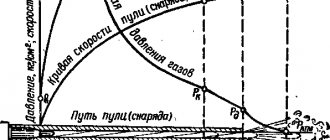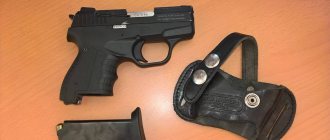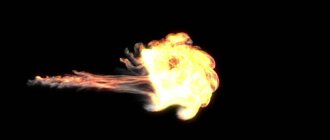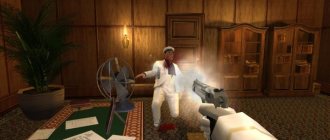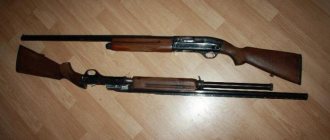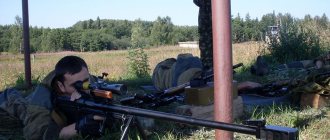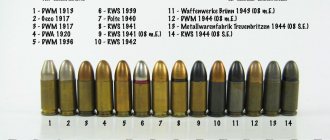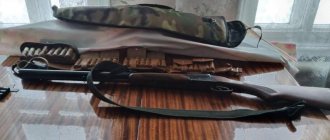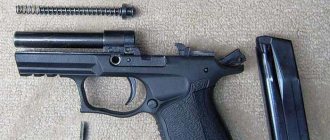Ballistics
Details Category: Sniper Date of publication 06/21/2013 18:01 Author: Super User To successfully master the technique of shooting from any small arms, you need to have a good knowledge of the laws of ballistics and a number of basic concepts related to it.
Not a single sniper could or will do without this; without studying this discipline, a sniping training course is of little use. Ballistics is the science of the movement of bullets and projectiles fired from small arms when fired. Ballistics is divided into external and internal .
Shot from close range
Not close is a distance outside the range of close shot factors.
Usually it exceeds a distance of 5 m. Damage at this distance is caused only by the projectile, having one or another effect discussed above (Fig. 153). In addition to damage from the action of a bullet, soot deposits may occur at this distance. They were first noticed by I.V. Vinogradov (1952), who discovered that soot can reach the target and be deposited on the target in the area of the entrance hole at a distance of 100 meters or more in cases of damage two-layer target, when the distance between the layers is 0.5-1 cm
The soot of the shot rushes along with the bullet, remaining on its surface and in the rarefied space that appears behind the waves formed during the flight of the bullet and most of all according to the vortex path. The bullet, having pierced the first layer of the target, falls into the gap between both layers, the soot seems to dissipate in this space, settling on the back surface of the top layer and on the front surface of the second layer.
In 1955 I.V. Vinogradov established that the soot of a shot from a short distance has a jagged appearance and a gap between the edge of the hole formed by the bullet and the surface where the soot is applied. These signs are sometimes clearly expressed, but can also be invisible.
A shot at a person wearing a bulletproof vest from a short distance (more than 10 m) is manifested by the overlay of metal particles and microelements coated with metal on the first layer of clothing. These particles are mainly located on the surface of the bullet, and a sharp impact on a solid barrier throws them onto the surface of the target around the entrance hole, which creates a false picture of a shot at close range, which must be remembered when determining the shot distance.
In practical work, it is sometimes necessary to differentiate gunshot injuries from puncture wounds, as well as tangential gunshot injuries from cut and chopped wounds. Differential signs of such wounds are presented in table. 13, 14.
| < Previous | Next > |
Internal ballistics
Internal ballistics studies the processes occurring in the bore of a weapon during a shot, the movement of a bullet along the bore and the accompanying aero and thermodynamic dependencies both in the bore and beyond until the end of the aftereffect of the powder gases.
In addition, internal ballistics studies the most rational use of the energy of a powder charge during a shot in order to provide a bullet of a given caliber and weight with an optimal initial velocity while maintaining the strength of the weapon barrel: this provides initial data for both external ballistics and weapon design.
Shot
A shot is the ejection of a bullet from the bore of a weapon under the influence of the energy of gases formed during the combustion of a cartridge's powder charge.
Shot dynamics . When the firing pin hits the primer of a live cartridge sent into the chamber, the percussion composition of the primer explodes, and a flame is formed, which is transferred to the powder charge through the seed holes in the bottom of the cartridge case and ignites it. With the simultaneous combustion of a combat (powder) charge, a large amount of heated powder gases are formed, which create high pressure on the bottom of the bullet, the bottom and walls of the cartridge case, as well as on the walls of the barrel bore and the bolt.
Under strong pressure of powder gases at the bottom of the bullet, it is separated from the cartridge case and crashes into the channels (rifling) of the weapon barrel and, rotating along them with an ever-increasing speed, is thrown out in the direction of the axis of the barrel channel.
In turn, the pressure of the gases on the bottom of the cartridge case causes the weapon (weapon barrel) to move backward: this phenomenon is called recoil . The larger the caliber of the weapon and, accordingly, the ammunition (cartridge) for it, the greater the recoil force (see below).
When fired from an automatic weapon, the principle of operation of which is based on the use of powder gas energy discharged through a hole in the barrel wall, such as in an SVD, part of the powder gases, after passing into the gas chamber, hits the piston and throws the pusher and bolt back.
The shot occurs in an ultra-short period of time: from 0.001 to 0.06 seconds and is divided into four consecutive periods:
- preliminary
- first (main)
- second
- third (period of aftereffect of powder gases)
Internal ballistics: shot, four shot periods
Preliminary shot period. It lasts from the moment the cartridge’s powder charge ignites until the bullet completely penetrates the rifling of the barrel. During this period, gas pressure is created in the barrel bore sufficient to move the bullet from its place and overcome the resistance of its shell to cut into the rifling of the barrel bore. This type of pressure is called boost pressure , which reaches a value of 250 - 600 kg/cm² depending on the weight of the bullet, the hardness of its shell, caliber, barrel type, number and type of rifling.
The first (main) period of the shot. Lasts from the moment the bullet begins to move along the bore of the weapon until the complete combustion of the powder charge of the cartridge. During this period, the combustion of the powder charge occurs in rapidly changing volumes: at the beginning of the period, when the speed of the bullet along the barrel is still relatively low, the amount of gases grows faster than the volume of the bullet space (the space between the bottom of the bullet and the bottom of the case), the gas pressure quickly increases and reaches its highest value - 2900 kg/cm² for a 7.62 mm rifle cartridge: this pressure is called maximum pressure . It is created in small arms when a bullet travels 4 - 6 cm.
Then, due to a very rapid increase in the speed of the bullet, the volume of the behind-the-bullet space increases faster than the influx of new gases, as a result of which the pressure begins to fall: by the end of the period it is equal to approximately 2/3 of the maximum pressure. The speed of the bullet constantly increases and by the end of the period reaches approximately 3/4 of the initial speed. The powder charge is completely burned shortly before the bullet leaves the barrel.
Second shot period. Lasts from the moment the powder charge is completely burned until the bullet leaves the barrel. With the beginning of this period, the influx of powder gases stops, but highly heated, compressed gases expand and, putting pressure on the bullet, significantly increase its speed. The pressure drop in the second period occurs quite quickly and the muzzle pressure at the muzzle of the weapon is 300 - 1000 kg/cm² for various types of weapons. Muzzle velocity , that is, the speed of the bullet at the moment it leaves the barrel, is slightly less than the initial speed.
The third period of the shot (the period of aftereffect of powder gases). Lasts from the moment the bullet leaves the bore of the weapon until the action of the powder gases on the bullet ceases. During this period, powder gases flowing from the barrel at a speed of 1200-2000 m/s continue to act on the bullet and impart additional speed to it. The bullet reaches its maximum speed at the end of the third period at a distance of several tens of centimeters from the muzzle of the weapon barrel. This period ends at the moment when the pressure of the powder gases at the bottom of the bullet is completely balanced by air resistance.
Initial bullet speed
The initial velocity of a bullet is the speed of the bullet at the muzzle of the weapon barrel. The value of the initial bullet velocity is taken to be a conditional velocity that is less than the maximum, but greater than the muzzle, which is determined experimentally and relevant calculations.
This parameter is one of the most important characteristics of the combat properties of a weapon. The magnitude of the muzzle velocity is indicated in the shooting tables and in the combat characteristics of the weapon. As the initial speed increases, the bullet's flight range, direct shot range, lethal and penetrating effect of the bullet increases, and the influence of external conditions on its flight decreases. The magnitude of the initial bullet speed depends on:
- bullet weight
- barrel length
- temperature, weight and humidity of the powder charge
- size and shape of gunpowder grains
- loading density
Bullet weight. The smaller it is, the greater its initial speed.
Barrel length. The larger it is, the longer the period of time the powder gases act on the bullet, and accordingly, the greater its initial speed.
Temperature of the powder charge. As the temperature decreases, the initial velocity of the bullet decreases; as the temperature increases, it increases due to the increase in the burning rate of the gunpowder and the pressure value. Under normal weather conditions, the temperature of the powder charge is approximately equal to the air temperature.
Weight of the powder charge. The greater the weight of the powder charge of the cartridge, the greater the amount of powder gases affecting the bullet, the greater the pressure in the barrel and, accordingly, the speed of the bullet.
Humidity of the powder charge. When it increases, the burning rate of gunpowder decreases, and accordingly, the speed of the bullet decreases.
Size and shape of gunpowder grains. Powder grains of different sizes and shapes have different burning rates, and this has a significant impact on the muzzle velocity of the bullet. The optimal option is selected at the stage of weapon development and during its subsequent testing.
Loading density. This is the ratio of the weight of the powder charge to the volume of the cartridge case when the bullet is inserted: this space is called the combustion chamber of the charge . If the bullet is seated too deeply in the cartridge case, the loading density increases significantly: when fired, this can lead to the rupture of the weapon barrel due to a sharp jump in pressure inside it, therefore such cartridges cannot be used for shooting. The higher the loading density, the lower the initial speed of the bullet; the lower the loading density, the higher the initial speed of the bullet.
Recoil
Recoil is the backward movement of the weapon at the moment of firing. It is felt as a push in the shoulder, arm, ground, or a combination of these sensations. The recoil effect of a weapon is approximately as many times less than the initial speed of a bullet, as many times the bullet is lighter than the weapon. The recoil energy of hand-held small arms usually does not exceed 2 kg/m and is perceived by the shooter painlessly. The recoil force and the recoil resistance force (butt support) are not located on the same straight line: they are directed in opposite directions and form a pair of forces, under the influence of which the muzzle of the weapon barrel is deflected upward. The greater the leverage of this pair of forces, the greater the deflection of the muzzle of a given weapon. In addition, when fired, the barrel of the weapon vibrates, that is, it makes oscillatory movements. As a result of vibration, the muzzle of the barrel at the moment the bullet leaves can also deviate from its original position in any direction (up, down, left, right).
You should always remember that the magnitude of this deviation increases with improper use of the shooting rest, contamination of the weapon, or use of non-standard cartridges.
The combination of the influence of barrel vibration, weapon recoil and other reasons leads to the formation of an angle between the direction of the axis of the barrel bore before the shot and its direction at the moment the bullet leaves the bore: this angle is called departure angle .
The departure angle is considered positive if the axis of the barrel bore at the moment the bullet leaves is above its position before the shot, negative - when below. The influence of the take-off angle on shooting is eliminated when it is brought to normal combat. But if the rules for caring for and preserving a weapon, the rules for attaching a weapon, or using a stop are violated, the value of the angle of departure and the engagement of the weapon changes. In order to reduce the harmful effect of recoil on shooting results, recoil compensators are used, located on the muzzle of the weapon barrel or removable and attached to it.
What is the fastest bullet in the world?
It was the first factory-loaded rifle cartridge with a muzzle velocity of over 1200 m/s. . The 220 Swift remains the highest velocity commercial cartridge in the world with a published velocity of 1422 m/s (4665 ft/s) using a 1.9 g bullet.
Interesting materials:
Why does xenon burn poorly? Why, according to Andreev, did Judas betray Christ? Why upon arrival? Why did the potato tops turn black? Why does kyphosis appear? Why does thrush appear? Why does carbon deposits appear on pistons? Why does fluid appear in the lungs? Why do milia appear? Why do stains appear on a down jacket?
What is the strength of a weapon barrel?
Strength is the ability of a barrel to withstand a certain pressure without permanent deformation. ... With prolonged use of the weapon, as well as with insufficiently thorough preparation for shooting, an increased gap may form between the shutter mirror and the barrel.
Interesting materials:
How are unstressed vowels marked? How to cancel iOS 14 update? How to undo undo in Illustrator? How to cancel a subscription to MTS music? How do I cancel my Teamo subscription? How to mark 9 days after death? How to clean dirt with soda? How to clean gouache from furniture? How to wash eggs? How to clean grease from laminate flooring in the kitchen?

